1. TAJCH
 The educational trail Zbojnícke studničky (Bandit Springs) connects individual springs and water sites, as well as the wetlands, where it renews and brings to life areas of ecological value. The trail leads from the water reservoir Tajch through Šarvíz to Kohútovo. In 9 themed stops, it gives visitors information on the springs, the natural water cycle, and the importance of forests for the country and for humans.
The educational trail Zbojnícke studničky (Bandit Springs) connects individual springs and water sites, as well as the wetlands, where it renews and brings to life areas of ecological value. The trail leads from the water reservoir Tajch through Šarvíz to Kohútovo. In 9 themed stops, it gives visitors information on the springs, the natural water cycle, and the importance of forests for the country and for humans.
The added value in connecting the educational trail Zvonička with the educational trail Zbojnícke studničky is that it offers attractive views of the surrounding nature, preserving also historical mining sites.
The trail with a length of 10 km is bidirectional, open throughout the year and easy. It takes 2,5 hours.
Water on Earth
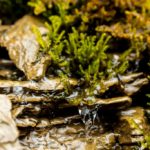 Earth, also called the blue planet, owes its other name to water. If viewed from space, you would see vast areas of water, covering two-thirds of the Earth’s surface. Water is present on our planet in various forms and can even be hidden below surface, be in the air as vapour or be frozen in the glaciers. The combined mass of water on Earth is hydrosphere, which changes and moves constantly. We call this process the water cycle.
Earth, also called the blue planet, owes its other name to water. If viewed from space, you would see vast areas of water, covering two-thirds of the Earth’s surface. Water is present on our planet in various forms and can even be hidden below surface, be in the air as vapour or be frozen in the glaciers. The combined mass of water on Earth is hydrosphere, which changes and moves constantly. We call this process the water cycle.
All water movement is caused by Earth gravity and by the energy from the sunlight. You may ask: ‘How can the Sun move water on Earth? ‘It is simpler than it may seem at first sight.
Let’s complete together all 9 stops of the educational trail Zbojnícke studničky and we will explain to you why water evaporates, how clouds form, why it rains, how water affects the Earth’s surface and much more.
2. TAJCH – WETLAND
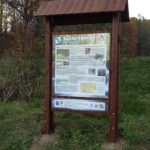 Wetlands are places where water is the main factor of influence for the area and for the plants and animals that live there. They form the transition between the aquatic and terrestrial ecosystems. They can be found along rivers and streams, near water reservoirs, dead river arms, wet depressions and springs. They are one of the most productive ecosystems on Earth and are important in preserving biodiversity. For humans, they are an important source of surface and ground water.
Wetlands are places where water is the main factor of influence for the area and for the plants and animals that live there. They form the transition between the aquatic and terrestrial ecosystems. They can be found along rivers and streams, near water reservoirs, dead river arms, wet depressions and springs. They are one of the most productive ecosystems on Earth and are important in preserving biodiversity. For humans, they are an important source of surface and ground water.
Water reservoir Tajch and its role in the past
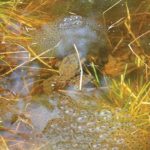 At present, Tajch serves as recreational area and for fishing. In the summer, the lake and its surroundings are ideal for recreation such as swimming, water sports and fishing. The bike path serves cyclists, inline skaters and runners, as well as walking tourists. In winter its frozen surface allows ice skating.
At present, Tajch serves as recreational area and for fishing. In the summer, the lake and its surroundings are ideal for recreation such as swimming, water sports and fishing. The bike path serves cyclists, inline skaters and runners, as well as walking tourists. In winter its frozen surface allows ice skating.
In the thirties of 18th century, mining in Nová Baňa was on the decline. The Court Chamber decided to solve the lack of needed water energy by building a water reservoir - tajch, which was to serve as source of water for running the mining and pumping machines. Due to various technical problems, the building of the water reservoir only began in 1792 and the budget was 25 061 gold coins. 92 workers worked on the site. The building was finished on 13 October 1794 and the reservoir contained 709 920 cubic fathoms of water. Tajch, with its network of water channels, served the needs of mining industry until the definite closure of mines in 1887.
Evaporation
Water on our planet exists besides the liquid and solid states also in the form of gas. So for a while, we will move from the world of water as we know it, into the air. One part of the Earth’s atmosphere is water vapour, which is produced by evaporation.
In your home, you encounter with vapour rising from boiling water every day. But did you know that in nature this process occurs continually, even at much lower temperatures? We call it evaporation from free surface. Evaporation is the process where vapour rises up from inanimate surfaces, such as water, soil or various objects. Apart from this, the water also evaporates from plants and animals, and then we call it transpiration. When these two terms are joined together, we get evapotranspiration.
So water vapour is all around us and we perceive its quantity as air humidity. It is thanks to the pleasantly wet air in the forest why we can breathe there so well. Water vapour in the atmosphere creates clouds via condensation… but you will learn more about that at the next stop of this trail.
3. JARMILA
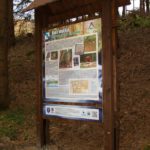 Jarmila is a place in the valley of Suchý potok (Dry brook), where in 1950 a small pond of the same name was built – the first in Nová Baňa.
Jarmila is a place in the valley of Suchý potok (Dry brook), where in 1950 a small pond of the same name was built – the first in Nová Baňa.
The pond Jarmila was built by the local Fishing Club. It was named after Mrs. Jarmila Tomešková, the then executive at Agricultural Committee in Bratislava, who was the godmother of the work, and supported its building. The pond was ceremonially opened on 18th June 1950, when it was also stocked with fish. Every member was during that season obliged to hand over the best of their caught fish to the fishing club, and thus contribute to the stocking and to the preparation of ceremonial lunch. The workers who took part in the build got lunch and a 50 litre barrel of beer.
The pond was destroyed just a few years later by a big downpour. All that remained is the partially visible rocky dam, the outlet and, hidden in the vegetation a few metres below, the concrete lid with the engraved name of JARMILA, the outline of a fish, and the year 1950.
Formation and types of clouds
Water in nature owes its constant movement to solar energy and gravitation. The sun’s rays hit the Earth’s surface and give energy to the surroundings. Heated Earth’s surface passes the warmth to the ground layer of air and, due to rising temperature, this air starts rising again, similar to a hot air baloon. As the warmed-up air rises higher and higher, it cools down. At certain height, the so far invisible water vapour starts to condense into small water droplets or ice crystals, and clouds are formed. You surely noticed that clouds differ in their appearance, height, colour etc. Based on these characteristics, we differentiate various types of clouds.
Thin white clouds with whispy strands, which form at great heights, are called Cirrus. These clouds are made exclusively from ice crystals, so you need not worry about rain.
On the contrary, you should be alerted if you see Nimbostratus in the sky - a thick grey layer of cloud, which sun-rays cannot penetrate. This type of cloud forms at medium to low altitudes above the surface and almost always brings precipitation.
During summer months, you can see in the sky thick and bright white clouds with flat bases, resembling lambs. Cumulus – meaning ‘heap’, forms at relatively low level and grows gradually up. This seemingly harmless cloud can nevertheless, carried by powerful upward currents of warm and wet air, change into a storm cloud, Cumulonimbus. This cloud extends to all height levels and while at lower altitudes it is made from water droplets, at higher levels it is made from ice crystals. Clouds of this type bring storms, hail, tornadoes and torrential rain.
4. LIPINSKA STUDNIČKA (LIME SPRING)
 The spring takes its name from the nearby lime growth. Lime tree is considered to be the symbol of Slavs, sometimes also the symbol of conciliation and love. It is planted in alleys and important locations.
The spring takes its name from the nearby lime growth. Lime tree is considered to be the symbol of Slavs, sometimes also the symbol of conciliation and love. It is planted in alleys and important locations.
Lime reaches heights of 40 metres and lives up to 600 years. Heart-shaped leaves of rich green colour have dentate edges. Stiped inflorescences grow from the leaf armpits, with 3-15 light yellow flowers. The flowers are picked in June, when they begin to blossom.
Honey made from lime is among the best. Its healing powers are used when treating bronchitis, cold, flu, angina, and also to bring down high temperature. Lime is favoured by carpenters and carvers. The wood is soft and easy to carve into.
Precious and protected is also the lime tree in Nová Baňa, which grows by the parish church in Nová Baňa. It was planted in 1726 on the occasion of renovating the church burnt out by Turkish army. At being nearly 300 years old, it has trunk diameter of over 580 cm and a height of 25 metres.
Where does precipitation come from?
The answer to this question seems simple – from clouds, of course. But why is it so? How is it possible that clouds full of water float in the sky, and sometimes precipitation falls from them and sometimes not?
At the previous stop of this trail you learned that clouds form when water vapour condenses. When cooled down to dew-point temperature, the water vapour changes into small droplets, about 100-times smaller than average raindrops. Droplets of water in clouds form mainly on condensation nuclei – tiny particles of dust and other particulates.
Molecules of water evaporate continuously from the surface of such a droplet, while other molecules condense on it. And it is the colliding and joining together of small droplets in the clouds that play vital role in creating precipitation.
While small droplets of water rise in the cloud in the warm updraft, bigger drops become too heavy to stay in it and, due to gravitation, fall out of the cloud.
5. JOHANSKÁ STUDNIČKA (JOHAN’S SPRING)
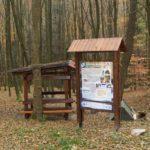 It is a sad legend, connected with this place... Once, hard times came upon the town. The mining was in decline and the creditors were putting pressure on the town magistrate. The masters could hardly drive off the clouds.
It is a sad legend, connected with this place... Once, hard times came upon the town. The mining was in decline and the creditors were putting pressure on the town magistrate. The masters could hardly drive off the clouds.
Johan was a simpleton from birth. He amused himself by playing with children and he wandered the woods. One day he was sitting somewhere by a spring and watching the sun through two pieces of coloured glass. All of a sudden, a small inquisitive dwarf stands behind him: ‘Give, give, let me see too!’ Johan shared the glass with him, and then they set about chasing and playing merrily. Dwarf granted him three wishes. Johan says: ‘I would like to eat!’ Dwarf offered him a sausage. Next, Johan came up with: ‘I would like a pile of those shiny little stones that my father digs in the mine.’ Dwarf pointed to a rock and there appeared a treasure of gold. Johan tied up his shirt and was pleased with how many stones he would bring to the children in town! People could not believe their eyes. At once they put Johan on a horse and they were all pressuring him to show them the place. Poor Johan could not remember where he came from, and so many adults around him shouting scared him. The horse went where it pleased and the people followed. When Johan saw that the horse started up a steep hill, he just sighed: ‘Oh, Johan, may you rather break your neck than to trudge up there! ‘
And that was his last wish... The townsmen never found the place. But the news of the treasure appeased the creditors and instigated the opening of new mines in the northeast of the town. Johan, although being a simpleton, saved the town. In his honour, they named the hill Johan and also one of his favourite springs Johan’s.
(The legend was written down by Jozef Hindický in the book And the bells do not toll)
Types of precipitation
Precipitation is a product of condensation or sublimation of water vapour which falls out from the clouds, either in liquid or in solid state. Vertical precipitation falls to the ground thanks to gravity. In this category is for example rain, which is formed by water droplets. Another form of vertical precipitation is for example hail (hailstorm), which forms in cumulonimbus storm clouds. Strong and warm updrafts in these clouds carry the water vapour to altitudes where ice crystals begin to form. Thanks to gravity, these fall down and they get again into the updraft, where another layer of water freezes on the crystals. This process is repeated several times and the hailstone grows up to a point where the updraft can no longer hold it in the cloud.
Snowflakes are formed, compared to hailstorm, in a much freer way. There are no strong updrafts in the clouds and water molecules have enough time to freeze into hexagonal structures. Snowflakes change continually from when they are first formed until they melt, and so an infinite number of interesting shapes are created.
Horizontal precipitation forms in the atmosphere thanks to horizontal air flow. Captured horizontal precipitation occurs when water vapour droplets or frost crystals get caught on various objects. Deposited horizontal precipitation is formed differently - as dew, frost, or hoar-frost. These are created from water vapour which condenses on the surface of plants or various objects.
6. ZBOJNÍCKE STUDNIČKY (BANDIT SPRINGS)
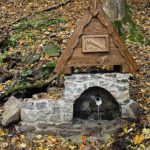 Zbojnícke studničky (Bandit Springs) are hidden behind the Háj massif.
Zbojnícke studničky (Bandit Springs) are hidden behind the Háj massif.
The group of bandits, looting in a vast area around the river Hron, had several hideouts. It was said they settled the abandoned castle of Ivankovo above the village Rudno nad Hronom, as well as a small stronghold tower near the village Jedľové Kostoľny.. In this tower, called Živánska, the gang held an old housewife. One day, the captain set from Rudno to Horné Hámre. When he was resting here by the springs, it occurred to him they might do with a new housewife. So he dragged a young girl from H. Hámre and he said to the old housewife: ‘Here, you witch, teach this young one!’ The girl was well paid, and the captain somehow started to treat her better. The old housewife knew well the girl’s story and she felt sorry for her. When they were alone, she told the girl what she was in for and the girl got scared. One day, all the bandits swarmed in the tower and stayed in there for several days. The housewife sensed they were probably searched for by the pandours. But because they had enough provisions in the tower, they felt safe and slept well. And so one day the housewife made a decision. She took the girl and led her out through the underground corridors. She bid her farewell, snatched the candle and made for the barrels full of gunpowder. She put the candle on one of the barrels and hurried away. Not long after, a terrible explosion was heard. The tower collapsed and only its eastern half was left as witness of the past. This was the end of the bandits’ looting in and around Nová Baňa.
(The legend was written down by Jozef Hindický in the book And the bells do not toll)
Surface water
Water falling on the Earth’s surface as precipitation is vital for plants, animals and the biosphere as such. The water cycle in nature continues on Earth’s surface in various ways. One of them is running off on the Earth’s surface.
In Slovakia, we come across water from streams, brooks, rivers, ponds, lakes and water reservoirs very often. The ridge of Karpaty is the main European water parting, which separates Baltic and Black Seas. From the rich river network in our country, 96 % of water goes to the Black Sea, with the remaining 4% going to the Baltic Sea. The total length of the river network in Slovakia is 49 775 km.
The rivers network shape is characterized by adjusting to the geological-geomorphological situation. For example Hron is typical for its penniform (feather-shaped) river network with straight and short tributaries.
7. HRAŠKOVA STUDNIČKA (HRAŠKO’S SPRING)
- native to Príbovce in Martin county, from 4 siblings, he dedicated his whole life to forestry. He studied at Forestry College in Pezinok. He became a forester in Horná Štubňa, later came to work in Nová Baňa. Here he got married, had daughter Andrea and together with his brother-in-law Ján Adamec from Nová Baňa they worked for National Forests, state organization.
Every inch the forester, he was responsible for the region from the railway station to Kajlovka, he supervised forest workers – lumberjacks and female forest workers. Near this spring stood once a cottage known as Hraško’s cottage, where the forest workers stored their tools. As they worked, they liked to come to the spring everyday because it offered refreshment and gave them new strength.
Ondrej Hraško was active also in Hunting Club in Nová Baňa. He was a big man, tall, friendly, open and funny. He fought for justice and he liked home- made cakes from his mother-in-law.
He died from pulmonary embolism at the age of 48 in Pezinok, and he is buried in Nová Baňa.
Ground water flow
When water falls on earth’s surface, part of it runs away over the surface and another part soaks into the soil through permeable rocks, cracks or cavities, into deeper rock layers. Ground water becomes the source for water flows on the surface, or for the lakes, from which the water flows back into the oceans.
Ground water is important because it represents precious supplies of drinking water. It is enriched with minerals and at the same time it filters by running through sand and gravel. The biggest supplies of water by volume in Slovakia can be found underneath the area of Žitný ostrov, but we should also mention karst areas. Water in some less resilient rocks (limestone, dolomite), or water in the cracks of some harder rocks, created over thousands of years underground spaces – caves. When the conditions are right, various types of stalactite and stalagmite decoration can be formed. There are also some caves close to Nová Baňa. We find them in the Tríbeč range around the villages Malá Lehota and Píla. The best known is Jazvinská cave in Malá Lehota.
Some places have mineral healing water with beneficial health effects. In these places, wellness and spas are built.
8.PREDNÝ ŠARVÍZ (FRONT ŠARVÍZ)
 Forest and its role in catching water
Forest and its role in catching water
The importance of forests in the hydrological regime of water is huge because forests accumulate and slowly release big water supplies. Thanks to this, most of our streams and rivers have enough water even during extremely dry periods. Important is the winter season, when larger reserves of water accumulate in the snow in the forest, compared to non-forest land. Forests can catch vertical (rain, snow, dew), as well as horizontal precipitation (mist) on the surface of trees, undergrowth, herbal ground cover, litterfall and in the soil. Forests influence not only the amount of water and the richness of surface and ground water sources, but also the quality of water. They function as natural water treatment sites, which protect surface and ground water from pollution with soil particles or chemical substances.
Basic information about educational trail Zvonička
Educational trail Zvonička, with a length of 6 km, the total elevation gain of 274 m, is bidirectional, circular, open throughout the year, and easy. There are 5 information panels on the route with information about the given area: Zvonička (Bell Tower), Červená skala (Red Rock), Havrania skala (Raven Rock), Háj, Kohútovo and 3 panels with panoramic views. Near Havrania skala, towards Zvonička, there is the open entrance of the Klingsbittner gallery.
By turning onto the educational trail Zvonička you will get to the lookout tower Háj - one of the best view locations around Nová Baňa.
The small and the large water cycles
Water is indispensable for life on Earth. No new water is created in nature, it only exists in various forms and states, and it circulates continually.
Due to sun radiation the water from the rivers, lakes and oceans evaporates (evaporation) and enters the atmosphere as water vapour. Through physiological processes in plants, the water transfers to the atmosphere also from plants and from the soil covered with vegetation (evapotranspiration). High above the ground, the water vapour cools down, it condenses, and clouds are formed.
Water gets back to the Earth’s surface in the form of precipitation. Rain water soaks in the soil (infiltration), or becomes part of the surface water of streams (surface runoff). Water soaked in the land creates ground waters, which flow slowly in the soil (subsurface flow) or rise again from the surface as springs. Ground water thus becomes the source for surface water in streams, brooks, rivers, or lakes, from which the water runs into seas and oceans.
Part of the fallen precipitation evaporates again and the circulation of water (hydrological cycle) continues. This water circulation is called the large water cycle. Circulation of water which only takes place above the surface of oceans (rain from water evaporated from oceans falls back into the oceans) is called the small water cycle.
9. KOHÚTOVO – Rovienka
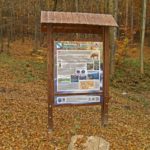 With this place, commonly known as Kohútovo, a legend is connected. In 1863, something extraordinary happened in Nová Baňa. The legend tells the story of children who shepherded sheep here during a great drought. Suddenly, one of the sheep began to dig the ground with its hoof. The curious children started to dig there too, when suddenly a spring of water gushed out of the ground. The locals sensed straight away that it was something unusual and, as thanks, hung an image of Virgin Mary on the nearby cherry tree. Later they started to come and pray here, and also to take water not just for their use but also when they had various illnesses. Štefan Moyses, the bishop of Banská Bystrica, proclaimed this place gracious in 1866.
With this place, commonly known as Kohútovo, a legend is connected. In 1863, something extraordinary happened in Nová Baňa. The legend tells the story of children who shepherded sheep here during a great drought. Suddenly, one of the sheep began to dig the ground with its hoof. The curious children started to dig there too, when suddenly a spring of water gushed out of the ground. The locals sensed straight away that it was something unusual and, as thanks, hung an image of Virgin Mary on the nearby cherry tree. Later they started to come and pray here, and also to take water not just for their use but also when they had various illnesses. Štefan Moyses, the bishop of Banská Bystrica, proclaimed this place gracious in 1866.
Basic information about the educational trail
The educational trail Zbojnícke studničky (Bandit Springs) connects individual springs and water sites, as well as the wetlands, where it renews and brings to life areas of ecological value. The trail leads from the water reservoir Tajch through Šarvíz to Kohútovo. In 9 themed stops, it gives visitors information on the springs, the natural water cycle, and the importance of forests for the country and for humans.
The trail with a length of 10 km is bidirectional, open throughout the year and easy. It takes 2,5 hours. From stop No.9 you can continue directly to town centre (20 min.), or you can make your tour longer along the educational trail Zvonička.
Sources of water on Earth
Hydrosphere represents all the water on Earth – in liquid, solid and gas states, on and under the surface, and in the atmosphere.
Oceans have 98 % of all water on Earth and they cover roughly 70 % of the Earth’s surface, which is why we call the Earth the blue planet. The World Ocean is divided into Arctic Ocean, Pacific Ocean, Atlantic Ocean and Indian Ocean (according to newer sources also Southern Ocean is proposed).
Water on the surface is mostly locked up in glaciers (74%) and also underground (25%). The rest of the surface water is contained in rivers, lakes, or reservoirs. The biggest source of fresh water is in North America (25%), mainly in the complex of Great Lakes in Canada. More than 20% of fresh water is in African lakes. The third largest fresh water ‘tank’ is the lake Bajkal (20%) and it is the deepest and oldest in the world. Rivers carry the water through their network into the World Ocean. But there are also areas with no runoff, where water ends in the lake, or in depressions without runoff. This is also the case of the biggest lake in the world, the Caspian Sea.







